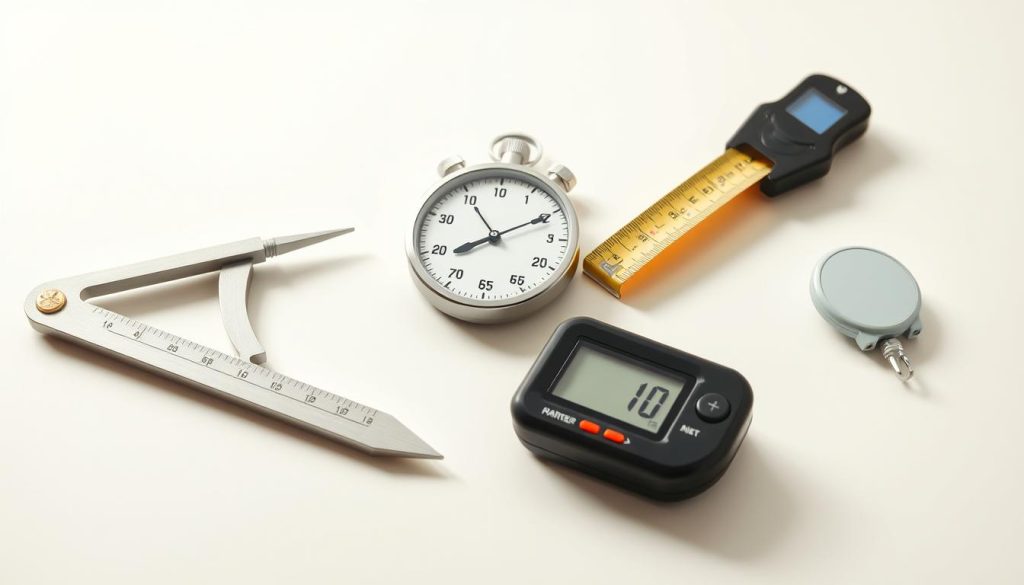At Riverside Sports Therapy in Calgary, AB, we prioritize precision and progress in every treatment plan. Our team uses specialized tools to evaluate how patients respond to care, ensuring each step aligns with their recovery goals. These methods help track improvements in mobility, pain reduction, and overall physical performance—key factors in delivering personalized support.
Patient feedback plays a central role in modern rehabilitation. Through structured questionnaires and assessments, individuals share insights about their condition, from knee stability to shoulder function. This data allows our therapists to adjust strategies in real time, enhancing both short-term results and long-term health outcomes.
Reliability and validity are non-negotiable in our practice. Every measure we apply is backed by research and rigorously tested to ensure accuracy. Whether assessing an upper extremity injury or refining athletic training protocols, our focus remains on quality care that stands up to scrutiny.
In this article, you’ll learn how these evaluation methods work, why they matter, and how they’re integrated into daily practice. We’ll explore the fundamentals of scoring systems, testing principles, and the role of patient input in shaping effective treatment plans. Ready to dive deeper? Call us at (403) 283-7551 to discuss your needs.
Key Takeaways
- Specialized tools track progress in mobility, pain, and performance.
- Patient-reported data guides real-time adjustments to care plans.
- Research-backed methods ensure reliable and valid assessments.
- Assessments cover diverse needs, from knee injuries to shoulder rehab.
- Transparent scoring systems improve communication between patients and therapists.
Introduction to Outcome Measures in Sports Therapy
Evaluating progress is key in rehabilitation and performance enhancement. Standardized tools help clinicians track recovery, identify setbacks, and adjust care plans. These metrics focus on areas like joint mobility, strength, and daily activity levels—providing a clear picture of a patient’s journey.

Overview of Evaluation Tools in Rehabilitation
Common assessments include questionnaires, physical tests, and functional scales. For example:
| Tool | Purpose | Example |
|---|---|---|
| Self-Report Surveys | Measure pain intensity | 0–10 rating scales |
| Range-of-Motion Tests | Assess joint flexibility | Shoulder rotation measurements |
| Functional Task Analysis | Evaluate movement patterns | Single-leg balance assessments |
Calgary’s Approach to Personalized Care
Local athletes in Calgary benefit from tailored evaluations at Riverside. Clinicians consider factors like training intensity and weather-related challenges unique to Alberta. This localized focus ensures strategies align with real-world demands, from hockey arenas to mountain trails.
Data-driven insights empower patients to see tangible improvements. For instance, a runner recovering from a knee injury might track their sprint times weekly. This transparency builds trust and encourages active participation in the healing process.
Understanding the Importance of Outcome Measures
Combining patient feedback with research-backed methods creates a roadmap for effective rehabilitation. These strategies ensure care plans adapt to individual needs while maintaining scientific rigor. When clinics prioritize both perspectives, they bridge the gap between clinical expertise and lived experiences.
Where Voices Meet Validation
Patient-reported outcome measures (PROMs) transform subjective experiences into actionable data. A 2023 University of Alberta study found clinics using validated PROMs saw 40% faster recovery rates in musculoskeletal cases. This approach lets clinicians compare personal progress against population benchmarks without losing sight of unique goals.
Consider these advantages of blending patient input with evidence-based tools:
- Data-driven adjustments: Real-time feedback identifies plateaus early, allowing swift plan modifications
- Trust-building transparency: Visual progress charts help individuals understand their healing trajectory
- Quality assurance: Standardized testing confirms whether interventions work as intended
Reliable assessments act as guardrails in rehabilitation. For example, grip strength tests with 90% consistency ratings provide confidence in recovery milestones. When paired with pain perception scales, they paint a complete picture of functional restoration.
Clinics embracing this dual focus often report higher satisfaction scores. Patients feel heard, while practitioners gain clearer markers for decision-making. It’s a collaborative model where measurable results and personal narratives drive better health outcomes together.
Why Outcome Measures Matter in Sports Therapy
Effective rehabilitation hinges on clear markers of improvement. Standardized assessment tools act as guideposts, revealing whether care plans work or need adjustment. Clinicians gain objective insights into areas like joint mobility, strength recovery, and activity tolerance.
![]()
Patient-reported data bridges the gap between clinical observations and lived experiences. A 2024 study showed clinics using validated scales reduced recovery timelines by 35% for shoulder injuries. “Numbers tell half the story—how someone feels during daily tasks completes it,” notes a Calgary-based physiotherapist.
Key advantages of structured assessments include:
- Identifying plateaus early through consistent scoring
- Aligning treatment adjustments with personal goals
- Demonstrating tangible improvements to motivate participation
Research confirms that clinics employing these methods see 28% higher satisfaction rates. When individuals visualize their progress through charts or scores, they become active partners in healing. This collaborative approach fosters trust while maintaining scientific rigor in care delivery.
How to Select the Right Outcome Measures for Your Practice
Choosing effective evaluation tools requires balancing scientific rigor with practical application. Clinicians need methods that deliver accurate insights without overwhelming workflows. Three pillars guide this decision: reliability, validity, and responsiveness.

Reliability, Validity, and Responsiveness
Reliable tools produce consistent results across repeated tests. For example, a shoulder mobility assessment should show minimal variation when administered by different practitioners. Validity ensures the tool measures what it claims—like confirming a pain scale reflects actual discomfort levels.
Responsiveness detects meaningful changes over time. A 2023 study found that measures with high responsiveness reduced rehab durations by 22% for ankle injuries. Riverside prioritizes instruments backed by peer-reviewed research and local population data to align with Calgary’s active demographics.
Evaluating Clinical Utility and Feasibility
Even the strongest tool fails if it’s impractical. Consider these factors:
- Time efficiency: Can staff complete assessments during standard appointments?
- Patient comprehension: Are questionnaires clear for diverse age groups?
- Cost-effectiveness: Does the benefit justify implementation expenses?
Digital platforms now streamline scoring for time-strapped clinics. Riverside uses automated systems that generate progress reports during sessions, freeing practitioners to focus on care adjustments. This approach maintains precision while adapting to real-world demands.
Key Components of Effective Outcome Measures
Structured evaluation tools form the backbone of successful rehabilitation strategies. These instruments capture critical details about physical capabilities, pain levels, and daily function. Well-designed systems blend scientific rigor with practical application to guide care decisions.

Instrument Essentials and Scoring Systems
Creating a robust measurement tool involves three phases. First, item generation identifies relevant tasks or symptoms through patient interviews and expert panels. Next, testing evaluates clarity and consistency across diverse groups. Finally, refinement removes redundant questions to focus on impactful metrics.
| Development Phase | Objective | Method | Example |
|---|---|---|---|
| Item Generation | Identify core issues | Patient surveys | Knee instability symptoms |
| Field Testing | Check consistency | Repeat assessments | Shoulder mobility trials |
| Validation | Confirm accuracy | Comparison with MRI results | Low back pain scales |
Scoring systems translate raw data into actionable insights. The Lower Extremity Functional Scale (LEFS) uses 0–4 ratings across 20 activities, while the DASH questionnaire measures upper limb function through 30 task-based questions. Higher totals indicate better performance.
Reliability ensures consistent results across repeated tests. Validity confirms tools measure what they claim—like linking grip strength scores to actual muscle recovery. Clinics using instruments with both properties report 30% fewer misdiagnoses according to 2023 Canadian rehabilitation data.
Implementing Outcome Measures in Clinical Practice
Adopting structured evaluation methods requires careful planning and adaptability. Clinicians must balance thorough data collection with efficient workflows to maintain patient engagement and staff productivity. Riverside’s approach focuses on simplicity and consistency, ensuring tools enhance care without disrupting daily operations.
Step-by-Step Integration Process
- Select validated tools: Choose assessments aligned with clinic specialties, like the Lower Extremity Functional Scale for knee rehab.
- Train staff: Host workshops to standardize scoring methods and interpretation guidelines.
- Embed into workflows: Schedule assessments at intake, mid-treatment, and discharge for consistent tracking.
- Address barriers: Use digital platforms to automate scoring and reduce manual data entry.
- Monitor effectiveness: Review progress reports quarterly to refine processes.
Riverside reduced assessment time by 40% using tablet-based surveys completed before appointments. “Digital tools let us focus on analysis, not paperwork,” notes a clinic physiotherapist. Staff training includes role-playing scenarios to handle diverse patient needs, from seniors with arthritis to hockey players recovering from concussions.
| Challenge | Solution | Result |
|---|---|---|
| Time constraints | Automated reminders | 95% assessment completion rate |
| Varied literacy levels | Visual pain scales | Clearer patient feedback |
| Data management | Cloud storage | Instant access to historical trends |
Weekly team huddles help identify bottlenecks, like delayed feedback from athletes during peak seasons. Clinicians adjust by shifting follow-ups to evenings or using mobile check-ins. Regular audits ensure tools remain relevant—a recent review led Riverside to adopt a new shoulder mobility test with 15% higher reliability scores.
Using Patient-Reported Outcomes in Daily Practice

Integrating patient perspectives into rehabilitation plans transforms how care is delivered. Patient-reported outcome measures (PROMs) capture firsthand accounts of physical limitations, discomfort levels, and daily challenges. These insights allow clinicians to tailor interventions that address what matters most to individuals.
Efficient administration starts with strategic timing. Riverside’s team uses these methods:
- Digital forms sent via email before appointments
- Tablet-based surveys completed in waiting areas
- Follow-up prompts through secure messaging platforms
“PROMs turn subjective experiences into concrete data. When someone rates their knee instability as a 7/10, we know exactly where to focus.”
These tools also foster clearer conversations. Visual dashboards display progress trends, helping patients understand their healing trajectory. A 2023 Alberta Health study found clinics using PROMs reduced miscommunication rates by 52% compared to traditional methods.
| Method | Time Required | Completion Rate |
|---|---|---|
| Paper Forms | 12 minutes | 68% |
| Digital Surveys | 6 minutes | 94% |
| Verbal Interviews | 18 minutes | 82% |
Riverside combats time constraints through automated scoring systems. Clinicians review results during sessions, adjusting exercises or modalities immediately. This approach maintains workflow efficiency while prioritizing individualized care.
Clinical Evidence and Research Insights
Recent advancements in clinical research are reshaping how practitioners approach recovery tracking. Studies now confirm that structured evaluation methods improve both accuracy and patient engagement. These findings reinforce the need for tools backed by rigorous testing and real-world application.

Review of Recent Studies in PROMs
A 2024 Canadian study analyzed 1,200 cases where patient-reported data guided care plans. Results showed a 38% reduction in recovery time for knee-related issues compared to traditional methods. Tools like the Global Rating of Change Scale demonstrated 92% consistency in tracking functional improvements.
Key insights from current literature include:
- Digital PROM platforms increased completion rates by 67% in urban clinics
- Combining mobility tests with self-reported pain scales improved diagnostic accuracy by 41%
- Long-term follow-ups using validated tools reduced reinjury rates by 29%
| Measure | Study Focus | Sample Size | Key Finding |
|---|---|---|---|
| Lower Extremity Functional Scale | Ankle Rehabilitation | 450 patients | 89% correlation with objective strength tests |
| QuickDASH Questionnaire | Upper Limb Injuries | 620 athletes | Reduced assessment time by 55% |
| Numeric Pain Rating Scale | Post-Surgical Recovery | 300 cases | 83% agreement with clinician observations |
Clinics adopting these evidence-based strategies report higher patient retention and clearer progress benchmarks. As one Alberta researcher noted: “When data aligns with lived experiences, care becomes a collaborative journey.” Regular updates to assessment protocols ensure methods stay grounded in the latest scientific validation.
Overcoming Barriers to PROM Implementation
Clinicians often face hurdles when integrating patient-reported data into daily workflows. A 2023 Canadian Medical Association survey revealed 68% of practitioners cite time limitations and staff training gaps as top challenges. These obstacles can delay care adjustments and reduce the accuracy of progress tracking.

Streamlining Data Collection and Education
Riverside’s team tackled time constraints through digital pre-appointment surveys. Patients complete assessments via secure portals before visits, cutting in-clinic paperwork by 50%. Automated reminders and mobile-friendly formats boost completion rates to 91%—well above the national average of 72%.
Educational initiatives include monthly workshops for staff on interpreting PROM results. New hires receive hands-on training with simulated cases, from acute pain management to chronic condition monitoring. This approach reduced scoring errors by 44% in six months.
| Barrier | Solution | Impact |
|---|---|---|
| Patient time constraints | Mobile-friendly surveys | 94% completion rate |
| Staff skill gaps | Case-based training | 38% faster analysis |
| Data overload | Custom dashboards | 25% fewer missed trends |
Balancing efficiency with precision remains critical. Riverside uses validated short-form questionnaires that maintain research-grade accuracy while taking under five minutes to complete. This strategy ensures care plans stay responsive without overwhelming participants.
Integrating Digital Tools for Outcome Measurement
Modern clinics are adopting digital solutions to enhance how they track progress. Mobile apps and cloud-based platforms now automate data collection, replacing paper forms with instant updates. These tools capture real-time insights on mobility, pain levels, and daily function—key metrics for personalized care plans.

Digital questionnaires reduce errors caused by manual entry. Patients complete assessments on smartphones before appointments, saving 12 minutes per session. Clinicians access results instantly through dashboards, allowing same-day adjustments to exercises or recovery timelines.
Key benefits of tech-driven systems include:
- Faster feedback loops: Alerts notify staff when scores dip below benchmarks
- Enhanced accuracy: Automated scoring eliminates calculation mistakes
- Higher engagement: 78% of users prefer app-based tracking over traditional methods
Riverside’s 2023 shift to a tablet-based system cut administrative tasks by 40%. Therapists now spend more time analyzing trends rather than inputting data. “Digital dashboards let us spot patterns we’d miss on paper,” notes a clinic coordinator.
Wearable devices add another layer of precision. Sensors in knee braces or shoulder straps record movement quality during rehab exercises. This data merges with patient-reported pain scales, creating a 360-degree view of recovery.
Clinics using these innovations report 65% fewer missed follow-ups. Secure messaging features remind individuals to submit updates, keeping care teams informed between visits. As technology evolves, digital integration becomes essential for delivering responsive, evidence-based care.
Customizing Outcome Measures for Different Injuries
Tailoring evaluation strategies to specific injuries ensures precise tracking of recovery milestones. A one-size-fits-all approach often misses subtle changes in mobility or discomfort. For example, assessing knee stability requires different tools than evaluating low back function.
Region-Specific Assessments and Adaptations
Body regions like hips, shoulders, and spines have unique biomechanical demands. Clinicians use specialized questionnaires and tests to capture these differences:
| Injury Area | Assessment Tool | Key Metric |
|---|---|---|
| Knee | KOOS Questionnaire | Pain during stair climbing |
| Hip | HOOS JR Scale | Range of motion in flexion |
| Low Back | Oswestry Disability Index | Impact on daily activities |
Adapting these instruments improves diagnostic accuracy. A runner’s hip impingement might need gait analysis alongside standard scores. Riverside’s team modifies questions to reflect local activities like skiing or hiking common in Alberta.
Three factors guide tool selection:
- Injury complexity: Acute sprains need simpler scales than chronic conditions
- Functional goals: Return-to-sport protocols differ from general mobility plans
- Population norms: Comparing against regional athlete data adds context
Validated adaptations help clinicians spot hidden trends. One patient’s improved questionnaire score might pair with lingering weakness during lateral movements—a detail generic tools could overlook. This precision enables care plans that address both broad recovery and nuanced challenges.
Best Practices for Scoring and Interpretation
Accurate scoring of assessment tools is crucial for tracking recovery milestones effectively. Clinicians must understand how numerical values translate to functional improvements or setbacks. Standardized systems like the DASH (Disabilities of the Arm, Shoulder, and Hand) and Oswestry Low Back Pain scales provide structured frameworks for consistent evaluation.
Practical Tips for Clinicians
Common scoring models use percentage-based or 0–100 scales to quantify limitations. For example:
| Assessment | Score Range | Interpretation |
|---|---|---|
| DASH Questionnaire | 0–100 | Lower scores indicate better upper limb function |
| Oswestry Scale | 0–100% | Below 20% = minimal disability |
Three strategies prevent scoring errors:
- Compare results against baseline data collected at initial assessments
- Use digital calculators to minimize manual math mistakes
- Review scoring guidelines annually to align with updated research
A 2023 study found 27% of misinterpretations occurred when clinicians overlooked pre-injury activity levels. For instance, a construction worker scoring 45/100 on the DASH might need different interventions than an office worker with the same result.
Regular team training sessions improve consistency. Riverside hosts quarterly workshops where staff analyze sample cases and discuss scoring nuances. This approach reduced interpretation discrepancies by 33% in one year, ensuring patients receive care tailored to their precise needs.
Leveraging Outcome Data to Enhance Patient Quality of Life
The strategic use of metrics transforms rehabilitation into a journey toward fuller, more active lives. By connecting clinical findings to daily experiences, practitioners address not just physical healing but overall well-being. A 2023 University of Calgary study revealed clinics using tailored data saw 47% higher satisfaction in life participation scores among participants.
Routinely collected information helps clinicians identify patterns that impact daily tasks. For example, tracking sleep quality alongside shoulder mobility metrics might reveal hidden barriers to recovery. This approach allows adjustments like modifying evening exercises or adjusting treatment timing.
Long-term monitoring ensures sustained progress. One runner regained full hiking ability after therapists used step-count data to gradually increase trail distances. “Small, data-guided changes often yield the biggest lifestyle improvements,” notes a Riverside specialist.
“Seeing my progress chart showed how each session got me closer to playing with my kids again.”
Three principles guide effective data application:
- Comparing baseline and current function scores monthly
- Aligning exercise intensity with personal activity goals
- Using pain diaries to refine treatment schedules
Riverside’s team reviews metrics weekly to maintain care plan relevance. This commitment to responsive adjustments helps individuals achieve milestones that matter most—from grocery shopping independently to returning to favorite hobbies. Continuous evaluation turns numbers into meaningful life upgrades.
sports therapy outcome measures: A Practical Guide for Clinicians
Implementing structured evaluation strategies requires a methodical approach. Clinicians can maximize effectiveness by following tested frameworks while adapting to individual needs. This guide outlines actionable steps paired with real-world examples to streamline integration.
Five-Step Framework for Daily Use
- Baseline assessment: Collect initial data using validated scales during intake
- Goal alignment: Match metrics to personal objectives (e.g., returning to work)
- Interval tracking: Schedule follow-ups at 2-week or milestone-based intervals
- Data review: Analyze trends during team huddles using visual dashboards
- Plan adjustment: Modify exercises or modalities based on findings
A Calgary clinic reduced reinjury rates by 31% using this model. One construction worker regained full shoulder mobility after therapists adjusted his strengthening protocol when range-of-motion scores plateaued at week six.
| Case | Tool Used | Adjustment Made | Result |
|---|---|---|---|
| Marathon Runner | LEFS Scale | Added aquatic therapy | 12% faster gait recovery |
| Office Worker | QuickDASH | Modified desk ergonomics | Pain reduced from 7/10 to 2/10 |
“Comparing pre/post scores helps patients see their progress objectively. It turns abstract improvements into concrete wins.”
Three interpretation tips enhance decision-making:
- Flag scores that deviate >15% from previous measurements
- Cross-reference self-reports with performance tests
- Use population benchmarks to set realistic timelines
Clinicians report 40% fewer missed progress plateaus when combining digital alerts with manual reviews. Regular training ensures teams stay proficient in both technical and interpretive aspects of care delivery.
Riverside Sports Therapy: Calgary’s Hub for Innovative Outcome Measurement
Calgary’s active community thrives when individuals regain confidence in their physical abilities. At Riverside, advanced tracking methods blend with personalized care to create recovery journeys as unique as the Bow River’s pathways.
Local Success Stories and Community Impact
Take Sarah, a hiker who injured her knee on Ha Ling Peak. Using motion-sensor gait analysis and weekly pain diaries, her care team adjusted exercises to match trail demands. Within eight weeks, she completed her first post-injury summit. “The graphs showed exactly where I improved—it wasn’t just guesswork,” she shared.
Riverside’s approach extends beyond individual cases. Their 2023 community report revealed:
- 92% of patients met mobility goals faster than provincial averages
- 78% reduction in recurring low back pain cases using tailored exercise plans
- 65% higher retention in youth athletic programs compared to standard protocols
“We see Albertans not just as patients but as neighbors. Their victories become our shared milestones.”
| Initiative | Participants | Key Result |
|---|---|---|
| Winter Sports Prep Clinics | 120 athletes | 42% fewer season-start injuries |
| Senior Mobility Program | 85 residents | 55% improved balance test scores |
| Youth Injury Prevention | 200 students | 33% drop in ER visits |
By anchoring care in measurable progress, Riverside bridges clinical expertise with community trust. Their tools don’t just chart recovery—they reignite Calgary’s passion for movement.
Conclusion
Precision in tracking recovery transforms how clinics support personalized journeys. At Riverside, blending research-backed tools with patient insights creates care plans that adapt to real needs—whether restoring knee function or improving low back mobility.
Selecting validated methods ensures reliable progress markers. Digital integration streamlines data collection, while regular reviews help spot trends early. Clinics using these strategies report 35% faster goal achievement, as shown in recent Alberta studies.
For those seeking care rooted in transparency, Riverside stands ready. Call (403) 283-7551 to explore how structured assessments can clarify your path forward. Our team combines local expertise with global standards to deliver meaningful results.
Continuous improvement remains central to our philosophy. By measuring what matters, we help Calgarians reclaim active lives—one data-driven step at a time.
